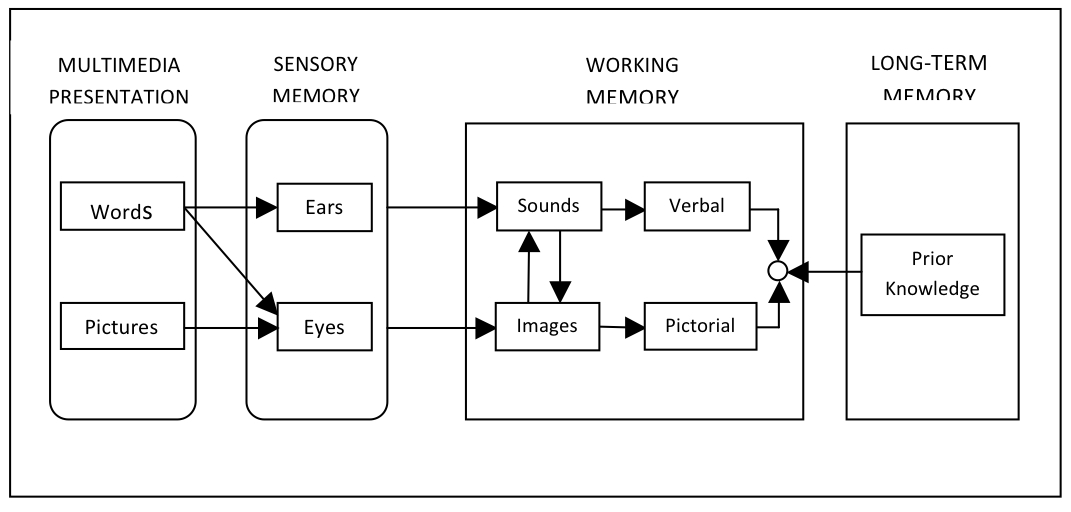Multimedia Learning
Definition
Multimedia learning as learning from words and pictures (Mayer 2005),
- The words can be printed (e.g., on-screen text) or spoken (e.g., narration).
- The pictures can be static (e.g., illustrations, graphs, charts, photos, or maps) or dynamic (e.g., animation, video, or interactive illustrations).
Multimedia instruction is intended to foster learning by presenting words and pictures.

Figure 1. Visual Representation of the Cognitive Theory of Multimedia Learning (sources: http://www.ied.edu.hk/apfslt/v12_issue2/rias/image1.jpg)
Basic Assumptions and Principles
Richard E. Mayer discusses twelve principles that shape the design and organization of multimedia presentations. Some examples are included:
- Coherence Principle People learn better when extraneous words, pictures and sounds are excluded rather than included.
- Signaling Principle People learn better when cues that highlight the organization of the essential material are added.
- Spatial Contiguity Principle People learn better when corresponding words and pictures are presented near rather than far from each other on the page or screen.
- Segmenting Principle People learn better from a multimedia lesson is presented in user-paced segments rather than as a continuous unit.
- Pre-training Principle People learn better from a multimedia lesson when they know the names and characteristics of the main concepts.
- Modality Principle People learn better from graphics and narrations than from animation and on-screen text.
- Multimedia Principle People learn better from words and pictures than from words alone.
- Personalization Principle People learn better from multimedia lessons when words are in conversational style rather than formal style.
Primary Theorist
Richard E. Mayer

Figure 2. Richard E. MayerSource: http://4.bp.blogspot.com/_IxJmnYEiLzA/SQipwPi5_QI/AAAAAAAAATQ/TlmKRm9y6xQ/s400/Richard-a-Mayer.png
Mayer’s best known contribution to the field of educational psychology is multimedia learning theory, which posits that optimal learning occurs when visual and verbal materials are presented together simultaneously.
He reported plenty of experimental studies to test a dozen of multimedia principle which states that people learn more deeply from words and pictures than from words alone. The research-based principle are regarded as the basis for Mayers cognitive theory of multimedia learning.
Classroom Implication and Teaching Strategies
Multimedia may facilitate learning better than tailoring media to individual student differences (Reed, 2006). By using different media, teachers increase the likelihood that at least one type will be effective for every student.
As reviewed by Schunk (2012), instructional devices that assist multimedia learning are:
- Text signals that emphasize the structure of the content and its relationship to other material (Mautone & Mayer, 2001);
- Personalized messages that address students and make them feel like participants in the lesson (Mayer, Fennell, Farmer, & Campbell, 2004; Moreno & Mayer, 2000);
- Allowing learners to exercise control over the pace of instruction (Mayer & Chandler, 2001);
- Animations that include movement and simulations (Mayer & Moreno, 2002);
- Being able to interact with an on-screen speaker (Mayer, Dow, & Mayer, 2003);
- Taking a practice test on the material (Johnson & Mayer, 2009);
- Being exposed to a human rather than a machine-generated speaker (Mayer, Sobko, & Mantone, 2003).
Resources
- Mayer, R. E. (2002). Multimedia learning. Psychology of Learning and Motivation, 41, 85-139.
- Mayer, R. E., & Moreno, R. (2003). Nine ways to reduce cognitive load in multimedia learning. Educational psychologist, 38(1), 43-52.
References
- Mayer, R. E. (Ed.). (2005). The Cambridge handbook of multimedia learning. Cambridge University Press.
- Reed, S. K. (2006). Cognitive architectures for multimedia learning. Educational Psychologist, 41(2), 87-98.
- Schunk, D. H. (2012) Learning theories: An educational perspective. New York, NY, England: Macmillan Publishing Co, Inc.